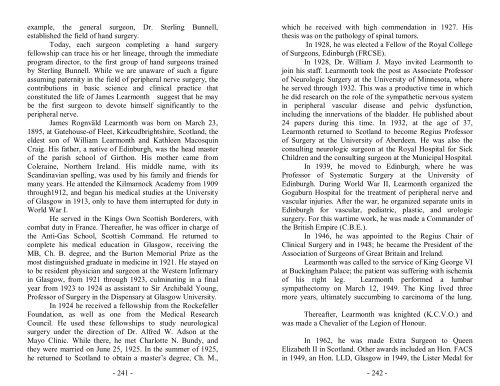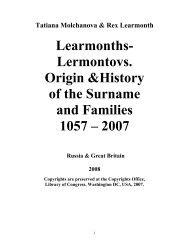LEARMONTH-LERMONTOV. A HYISTORY OF THE NAME AND FAMILIES
By Tatiana Molchanova and Rex Learmonth, 2011
By Tatiana Molchanova and Rex Learmonth, 2011
- No tags were found...
Create successful ePaper yourself
Turn your PDF publications into a flip-book with our unique Google optimized e-Paper software.
example, the general surgeon, Dr. Sterling Bunnell,<br />
established the field of hand surgery.<br />
Today, each surgeon completing a hand surgery<br />
fellowship can trace his or her lineage, through the immediate<br />
program director, to the first group of hand surgeons trained<br />
by Sterling Bunnell. While we are unaware of such a figure<br />
assuming paternity in the field of peripheral nerve surgery, the<br />
contributions in basic science and clinical practice that<br />
constituted the life of James Learmonth suggest that he may<br />
be the first surgeon to devote himself significantly to the<br />
peripheral nerve.<br />
James Rognväld Learmonth was born on March 23,<br />
1895, at Gatehouse-of Fleet, Kirkcudbrightshire, Scotland, the<br />
eldest son of William Learmonth and Kathleen Macosquin<br />
Craig. His father, a native of Edinburgh, was the head master<br />
of the parish school of Girthon. His mother came from<br />
Coleraine, Northern Ireland. His middle name, with its<br />
Scandinavian spelling, was used by his family and friends for<br />
many years. He attended the Kilmarnock Academy from 1909<br />
through1912, and began his medical studies at the University<br />
of Glasgow in 1913, only to have them interrupted for duty in<br />
World War I.<br />
He served in the Kings Own Scottish Borderers, with<br />
combat duty in France. Thereafter, he was officer in charge of<br />
the Anti-Gas School, Scottish Command. He returned to<br />
complete his medical education in Glasgow, receiving the<br />
MB, Ch. B. degree, and the Burton Memorial Prize as the<br />
most distinguished graduate in medicine in 1921. He stayed on<br />
to be resident physician and surgeon at the Western Infirmary<br />
in Glasgow, from 1921 through 1923, culminating in a final<br />
year from 1923 to 1924 as assistant to Sir Archibald Young,<br />
Professor of Surgery in the Dispensary at Glasgow University.<br />
In 1924 he received a fellowship from the Rockefeller<br />
Foundation, as well as one from the Medical Research<br />
Council. He used these fellowships to study neurological<br />
surgery under the direction of Dr. Alfred W. Adson at the<br />
Mayo Clinic. While there, he met Charlotte N. Bundy, and<br />
they were married on June 25, 1925. In the summer of 1925,<br />
he returned to Scotland to obtain a master’s degree, Ch. M.,<br />
- 241 -<br />
which he received with high commendation in 1927. His<br />
thesis was on the pathology of spinal tumors.<br />
In 1928, he was elected a Fellow of the Royal College<br />
of Surgeons, Edinburgh (FRCSE).<br />
In 1928, Dr. William J. Mayo invited Learmonth to<br />
join his staff. Learmonth took the post as Associate Professor<br />
of Neurologic Surgery at the University of Minnesota, where<br />
he served through 1932. This was a productive time in which<br />
he did research on the role of the sympathetic nervous system<br />
in peripheral vascular disease and pelvic dysfunction,<br />
including the innervations of the bladder. He published about<br />
24 papers during this time. In 1932, at the age of 37,<br />
Learmonth returned to Scotland to become Regius Professor<br />
of Surgery at the University of Aberdeen. He was also the<br />
consulting neurologic surgeon at the Royal Hospital for Sick<br />
Children and the consulting surgeon at the Municipal Hospital.<br />
In 1939, he moved to Edinburgh, where he was<br />
Professor of Systematic Surgery at the University of<br />
Edinburgh. During World War II, Learmonth organized the<br />
Gogaburn Hospital for the treatment of peripheral nerve and<br />
vascular injuries. After the war, he organized separate units in<br />
Edinburgh for vascular, pediatric, plastic, and urologic<br />
surgery. For this wartime work, he was made a Commander of<br />
the British Empire (C.B.E.).<br />
In 1946, he was appointed to the Regius Chair of<br />
Clinical Surgery and in 1948; he became the President of the<br />
Association of Surgeons of Great Britain and Ireland.<br />
Learmonth was called to the service of King George VI<br />
at Buckingham Palace; the patient was suffering with ischemia<br />
of his right leg. Learmonth performed a lumbar<br />
sympathectomy on March 12, 1949. The King lived three<br />
more years, ultimately succumbing to carcinoma of the lung.<br />
Thereafter, Learmonth was knighted (K.C.V.O.) and<br />
was made a Chevalier of the Legion of Honour.<br />
In 1962, he was made Extra Surgeon to Queen<br />
Elizabeth II in Scotland. Other awards included an Hon. FACS<br />
in 1949, an Hon. LLD, Glasgow in 1949, the Lister Medal for<br />
- 242 -






